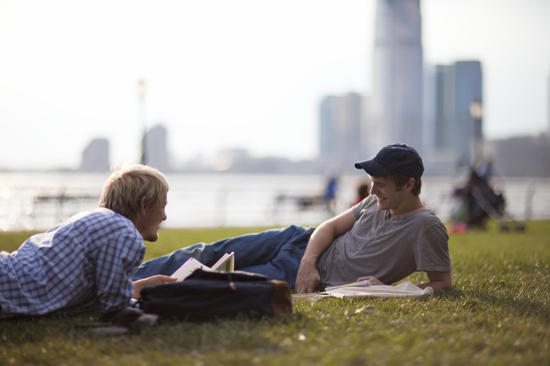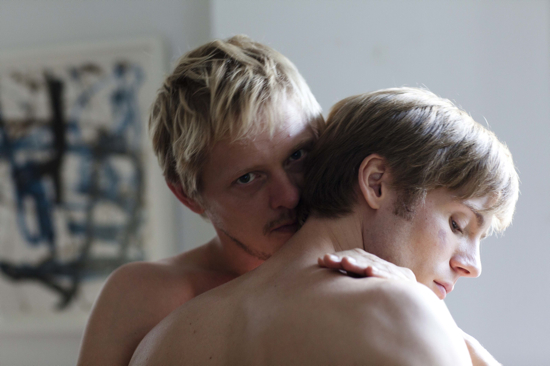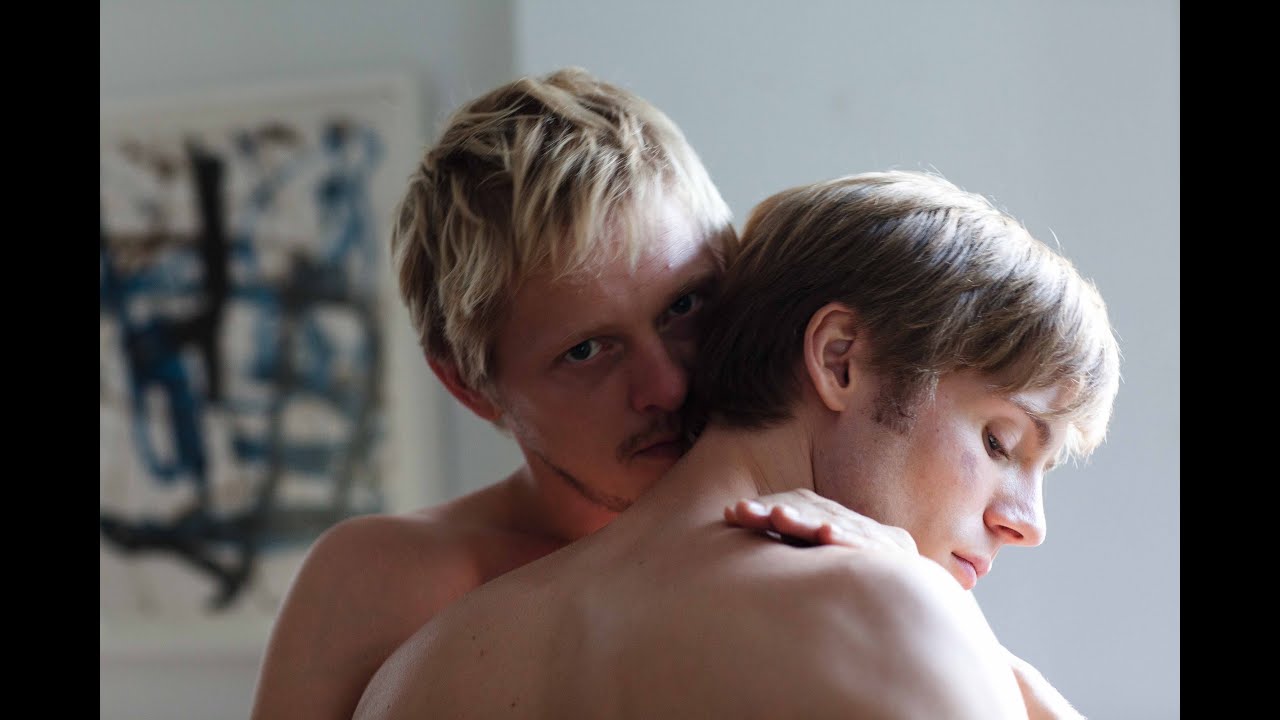Keep The Lights On, the new film by New York-based director Ira Sachs, tells the story of a tumultuous 10-year relationship between documentary filmmaker Erik (sensitively played by Danish actor Thure Linhardt), and Paul (Zachary Booth), a willowy, initially-closeted attorney who spirals into serious drug addiction.
Steeped in an insider’s knowledge of Downtown life, it’s a luminous, sensitive and often harrowing portrait which draws heavily upon the real-life relationship between Sachs and literary agent Bill Clegg (whose own story was published as a memoir this year).
The movie is also distinguished by its soundtrack, which extensively uses the work of late New York musician Arthur Russell, who died of AIDS in 1992 at the tragically young age of 40. Relatively unknown during his lifetime, Russell has since undergone a dramatic re-discovery, largely due to a series of posthumous reissues in 2004. He was commemorated on film with the beautiful 2008 documentary Wild Combination, directed by Matt Wolf, and was also the subject of an exhaustive 2009 book by Tim Lawrence, entitled Hold On To Your Dreams. There’s a hauntingly amorphous quality to Russell’s music (a trained cellist with a plangent singing voice, he dabbled in folk, disco and electronica) which suits the elliptical ebb and flow of the drama, and lends it a mood of wistful timelessness.
Russell’s indelible presence dovetails with a key thread that runs throughout: to excavate and celebrate queer artistic culture. In the film, the subject of the documentary that Erik is making is Avery Willard, described by Sachs as a "Broadway photographer, physique artist, gay activist, experimental filmmaker, drag historian, leatherman, pornographer", who – like Russell – produced a lifetime of historically significant work that had remained widely unseen for decades.
I sat down with Sachs at the recent London Film Festival to discuss his use of Russell’s music, the idea of New York as a creative life giver and taker, and the importance of recognising one’s subcultural history.
In Keep The Lights On you make extensive use of the music of Arthur Russell. What about his music so suits the film, and to what extent do you feel you’re continuing the excavation of his canon?
Ira Sachs: Well, excavation is a good word for me; I think the whole film is a form of excavation, of making visible the invisible. And also telling history. I think that’s one of the roles you have as a filmmaker, it’s one of the fortunate roles. You become the documenter of a time and a place and a city and the characters. I saw Wild Combination by my now friend Matt Wolf, which is a great movie. I was very moved by both the story and music and I had the idea that I could use Arthur Russell’s music similarly to how Simon & Garfunkel is used in The Graduate or Aimee Mann is used in Magnolia. I just thought, "Oh, I’m going to do that with Arthur Russell.’
I worked very closely with my editor Affonso Gonçalves and music editor Suzana Peric, and they spent months just listening to the entire catalogue. What I didn’t realise, and what’s been very moving to me, is the last song in the film is called ‘This Is How We Walk On The Moon’ – and in a way, I think that’s what the film also could be called. And that’s the excavation. The film is about how these two men walk on the moon but it’s also about how – and I bet London’s not too dissimilar from New York – we walk on the moon. And it’s different from when I started to make films. As a queer filmmaker, questions of identity were so central, the ‘coming out’ narrative, which is no longer – having lived 30-something years ‘out’ – that’s not where I’m struggling. I’m struggling with lots of things, but I think this film is a form of progress.
You mentioned Wild Combination, and I noticed some parallels. There’s a sense of peace when the characters move out from the city into open space. You’re from Tennessee and Arthur Russell is from Iowa. You both ended up in New York, which is a completely different vibe. To what extent do you think New York is a life giver and a life sapper?
IS: I think more the giver and the sapper is adulthood, more than the city itself. I think adulthood is hard. And I think all of my films have been about coming-of-age and the struggle of an individual to accept him/herself within their adult self, who they become. I think that’s there’s this internal turmoil… I don’t think New York is necessarily unique in causing that turmoil. On the other hand, I do feel like New York gripped me when I arrived there in a way that it took me until I was 40 to disentangle.
In what ways?
IS: Drugs and sex and love and career and ambition and all those things that were hopeful substitutes of what I was… I think I was a little alone in the struggle of what made life worth living and also what made me worth living it. And I think both these characters, there’s this sense that they’re not enough, that they need something else. I feel less like that, and I think that you still have hunger and drive and needs but I think the enormously compulsive energy of this film – we thought a lot about Goodfellas because I think that’s also a film driven by desire and told with the same energy the characters exhibit, and that was partially what I hoped. To make a film about bad behaviour but do so without judgement and without avoiding the consequences of that behaviour, and have the joys and the pleasures that cinematically come with that, so the film would be propulsive in a way.
Could you talk about the Avery Willard thread? There’s a real sense of the importance of bringing that subculture to life.
IS: Well, I think there’s lots of layers of excavation, to use that term. And this is a film that makes important the story of these two men, and yet it’s within the context of a lot of other stories that the film brings forward. Including the opening paintings, a series of portraits that are actually painted by my husband Boris Torres. The character of Igor is based on Boris – so Eric married Igor, which was something I didn’t want to put in the film per se, and yet, there was this sense that there were possibilities in the future. And I think what I wanted to say is that this story is important, but no more important than all the others that are layered into a city.
In general, I’m also trying to make a lot of things visible that aren’t visible, including the history of art-making in New York, and counterculture in New York. James Bidgood is the man interviewed in the middle [of Keep The Lights On, by Erik]. He is an underground filmmaker and made a film called Pink Narcissus [released in 1971]. That history is for me is super-inspiring and very different than the history of independent film. It’s not the history of sex, lies, and videotape and Reservoir Dogs. It’s the history of David Wojnarowicz and Félix González-Torres and even, in a certain way, John Waters. This underground that I feel isn’t economically rewarding but something else comes out of it, and it’s powerful. This film might be just that – I’m not sure that’s it’s economically rewarding but it’s powerful!

New York seems to be a character itself. Was that by design?
IS: Very much, to the extent that it took me 25 years to do it – I’ve been in New York for that long and hadn’t made a film there. I made a short film called Last Address in 2010 that’s eight minutes long. It’s about a group of New York artists who had died of AIDS, and I went and shot the last residence they lived in, so it’s just a series of images of their houses, and it dipped my toe into looking at the city as a narrative filmmaker.
I see a city within a context of a story about intimacy, so you view the city from the inside. I think that’s very much how the city comes out to the audience. It’s how these people live in the city, so there’s very few exteriors, not a lot of wide shots; so you often see houses and restaurants and apartments and bedrooms and I think by doing that, with some sense of flair, you tell the truth, in the sense that you’re making lots of choices.
Keep The Lights On is in selected UK cinemas now; a full list of screenings can be found at the Peccadillo Pictures website. Ashley Clark runs the fine film blog Permanent Plastic Helmet.



